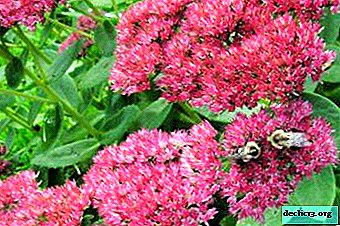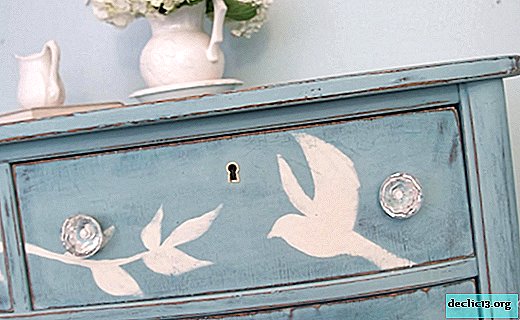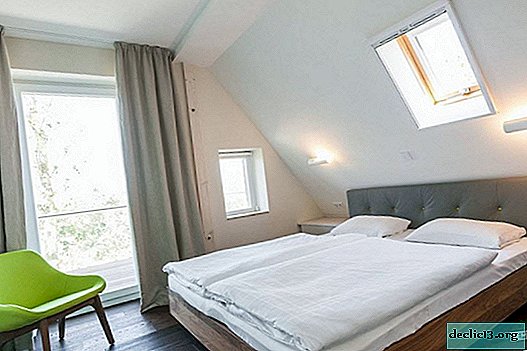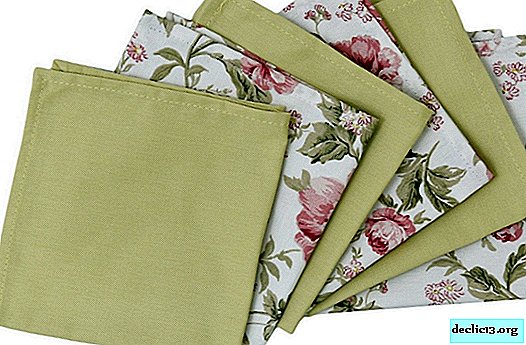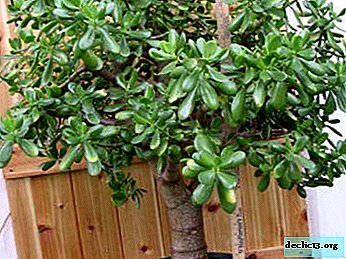Unusual tulip-shaped geranium: what kind of flower is it and how to care for it?
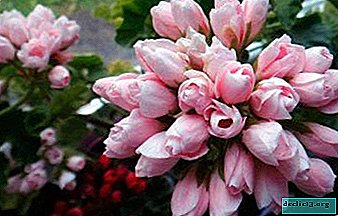
Among the many types and varieties of geraniums that are everywhere decorated with window sills, flowerpots, flowerbeds and terraces, there are very unusual ones that attract at first sight with their beauty and unusualness.
Pelargonium (geranium) is tulip-shaped, which is sometimes mistakenly called "tulip".
Luxurious, full-bodied flower, very different from other representatives of its kind.
Species history
This type of geranium appeared in the city of Boston, in America in 1966. in the Andrea family nursery. The first variety to be bred was named Patricia Andrea. The version was put forward that he appeared as a result of a mutation. Breeders from the Andrea nursery say that this is not so, this species was obtained as a result of hybridization. For several years, several more varieties of this unusual geranium were bred in this nursery. They were named after the women of breeder families: Patricia, Carmen, Victoria, Lilian and Linea.
On a note. The cultivation of new varieties in tulip-shaped geraniums is complicated by the structure of the flower itself. The petals are folded, like a tulip, so the pistil and stamen are almost inaccessible and are difficult to pollinate.This explains why there are so few varieties of this flower. In total there are now 14 varieties and hybrids.
External features
Reminiscent in shape of unbroken buds of tulips, semi-double flowers consist of eight thin petals and are collected in inflorescences of 30-50 pieces.
The color of their different colors, from pink to burgundy with streaks on the outside of the petals.
The leaves of this species are shiny and quite stiff. It reaches heights, depending on the variety, from 30 to 70 cm.
The most popular varieties
- Herma. It stands out with luxurious large inflorescences of red-orange color. A fairly unpretentious, compact plant, which is popular for spectacular and long flowering - from April to September.
- Emma fran Bengtsbo. Very beautiful variety, with plain green leaves and oblong-shaped flowers with a delicate light pink hue. Requires systematic pruning to form a crown, a tall plant. Sensitively reacts to watering, with a lack of moisture, the leaves begin to curl up.
- Lilian Andrea. A variety that grows well has a compact crown. Blossoms in raspberry color long enough. Beautiful shape of flowers with petals slightly sharpened upwards. The leaves are green, slightly velvety.
- Marbacka Tulpan. Florists call this variety "indomitable blonde." The flowers in the form of a lush capsule are white, with a slight pinkish tinge, the leaves are bright green, round, neat. At the bush, it is necessary to regularly form a crown.
- Red Pandora Very non-whimsical variety with dark green foliage. Inflorescences are red, with light veins, the shape of the buds is slightly rounded.
- Patricia Andrea. The leaves of this variety are glossy with clear, as if cut out edges. Classically tulip-shaped flowers of simple shape. This variety is very in demand for a special color scheme. Carmine red with delicate pink bursts of buds look very impressive.
Photo
Next, you can find a photo of the tulip-shaped geranium, whose inflorescences resemble the outlines of tulips.





Necessary conditions and care at home
This type of geranium is as unpretentious as the rest of geraniums, but still there are certain conditions that must be observed. This is an exclusively indoor plant, open ground in the Russian climate is harmful to it.
Light and location
The plant prefers diffused light, but the lighting should be good enough, otherwise the flower stretches, blooms worse, fades. From direct sunlight, burns may appear. on pretty delicate leaves. In winter, lighting is supplemented with phytolamps, then geranium can bloom all year round.
Note! A room with pelargonium should be regularly ventilated, but drafts should be avoided.Also, do not place the flower next to central heating appliances, the hot air emitted is harmful to it.
The soil
For planting, you can use the usual universal soil for indoor plants or make the soil mixture yourself.
It is necessary to proceed from the following proportions:
- two parts of ordinary land, two parts of peat, one part of coarse sand - for young plants;
- two parts of peat, two parts of humus, two parts of turf and one part of sand - more suitable for old pelargonium plants.
 Be sure to make a good drainage layer at the bottom of the pot. For this, expanded clay is used.
Be sure to make a good drainage layer at the bottom of the pot. For this, expanded clay is used.
Lack of drainage and excess moisture can lead to decay of the root system and death of the plant.
Pots are best chosen from wood or clay. If the capacity is too large, the tulip-shaped geranium will not bloom.
It is advisable to use pots with a diameter of about 14 cm, a height of 10-15 cm. It is necessary to transplant the flower, depending on the growth, every two to three years.
Important! Tulip-shaped geraniums are always placed in pots with a tray, where excess water flows, which must be drained.If these conditions are not met, the root system rots, the plant dies.
When caring for this plant, you should observe the regime of watering, pruning, feeding, and also protect it from diseases and insects in time.
Diseases and Pests
- Whitefly
Symptoms: yellowing and falling of leaves.
Treatment: spraying with insecticides - "Decis", "Acarin".
- Spider mite.
Symptoms: a small cobweb forms on the plant, small insects appeared, yellow and white dots, dry leaves.
Treatment: the leaves must be treated with alcohol, "Zolon" or "Ditox" will also help.
- Mealybug.
Symptoms: white plaque, similar to cotton wool.
Treatment: a flower with a cotton pad dipped in a soap solution, completely cleaned from insects.
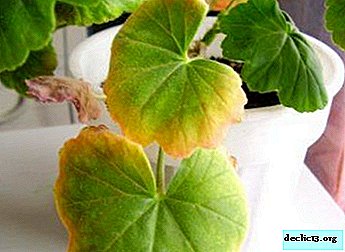 Rust.
Rust.Symptoms: the appearance of white circles on leaflets.
Treatment: leaves and branches that are damaged should be removed, then treated with fungicides.
- Gray rot.
Symptoms: plaque dark gray on the foliage.
Treatment: remove the affected leaflets, treat with fungicides, for example, Fundazol.
- Blackleg.
Symptoms: foliage turns yellow, curls, then falls, the stems turn black.
Treatment: unfortunately, treatment in this case will not help, in order to avoid infection of other plants, the flower needs to be eliminated.
Propagation Features
As with all geraniums, reproduction is possible in two ways: planting seeds and cuttings.
From seed
Landing in the winter, in January. The soil is taken the same as for an adult plant. Seeds for planting can be taken from a faded flowerbut before they hit the ground, processing is needed. First enin, after a solution of potassium permanganate, in which the seeds are about 20 minutes. Then the planting material is washed and sent to warm water for 3 hours.
Sowing is done to a depth of about 3-5 mm, sprayed with water and covered with a film or glass on top to create greenhouse conditions. Periodically, an improvised greenhouse should be opened for airing and preventing the formation of mold. Be sure to create additional lighting and maintain the temperature not lower than + 20-22.
After the appearance of 2-3 leaves, a pick is necessary, and only after another two months you can transplant the plant into a pot.
On a note. It is believed that hybrid varieties cannot be propagated by seeds, varietal qualities are lost.To be sure of the result, it is better to use cuttings or purchase seeds in specialized retail outlets.
Proper sowing of geranium seeds:
Cuttings
This is the most commonly used method for producing new plants. At the end of summer, cuttings of about 10 cm are cut with two to three leaves. Inflorescences from the stalk are removed, then placed in water until roots are formed. After this, transplanted into a pot and placed on the sunny side.
Tulip-shaped geranium, although very unpretentious, still requires some care, without which its beautiful buds will begin to open and the plant will lose its original appearance, will become like ordinary geranium.
To prevent this from happening, you should remember some rules:
- you need to pinch the shoots from time to time, then the bush will be lush;
- remove fading inflorescences, then new buds will grow;
- if the flowers began to open and lost the shape of the tulip, they should be removed as soon as possible;
- Do not keep the flower where there is wind or draft.
Cutting geraniums:
Observing these simple conditions, you can enjoy the beauty of this beautiful plant all year round. With its presence, tulip-shaped geraniums will make the house cozy, easily fit into any interior and will delight owners and guests with their unusually spectacular flowering for many years

 Rust.
Rust.





